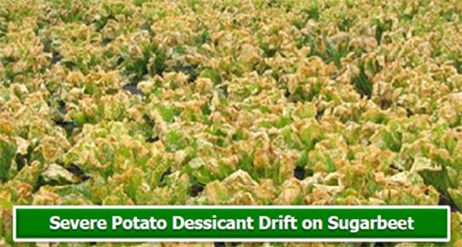580 - On Target Pesticide Applications

PESTICIDES ARE ONLY EFFECTIVE WHEN APPLIED ON THE intended target at the right rate at the right time. It is certainly important to maximize the effectiveness of these expensive inputs every time they are applied. Serious injury to non-target crops can occur if pesticides are misapplied.
Development of new spray application equipment technology has made it easier than ever to correctly apply pesticides. New nozzles, boom management options, pressure and droplet size control technology should make drift events almost non-existent given reasonable operator care.
Steps on Target Application Success
- Nozzles Selection - Air induction type nozzles available today are one of the best choices available. Attention must be given to droplet size and other factors too. Many sprayers have booms with multiple tip options.
- Lower Spray Pressure - The old adage was always to reduce pressure to reduce drift. However nozzle technology advances today don't necessarily dictate low pressure is a must. Using recently developed designs of air induction nozzles will maintain a combination of higher pressure and optimal droplet size to maximize herbicide activity while reducing drift.
- Water Volume - The accepted practice is using larger spray orfices and increased spray volume which result in larger droplets and reduced drift. However this can be easily compromised in the need to reduce spray volumes to spray more acres in less time. Don't compromise and increase the risk of spray drift occurrences.
- Boom Height Management - Keep boom heights as low as possible. Changing nozzles to achieve this objective may be necessary. Very wide booms, high travel speeds, and rough field surfaces increase spray drift risk.

- Speed of Operation - Faster operation speeds and need to maintain a constant gallon per acre application rate require increased spray pressure. As pressure increases droplet size decreases and spray drift risk increases. To double the flow from a given spray tip size, pressure has to increase four fold. High speed also decreases boom height control.
- Monitor the Weather - Too much or too little wind can both be a problem. When glyphosate first was registered for use university personnel and Ag staff observed drift nearly 5 miles from the point of application with a prolonged inversion. Drift risk with high winds is an obvious problem. Check the nearest NDAWN station or other weather stations for wind. Avoid spray applications during inversion conditions at all cost near crops sensitive to a given herbicide.
- Buffer Zone Utilization - Avoid an area adjacent to a sensitive crop if wind conditions are wrong. As new stacked herbicide resistant crops are planted drift damage risk will greatly increase.
- Drift Management Options - Use drift reduction adjuvants if they do not interfere with pesticide efficacy. Wind shields can definitely reduce risk as well. Good common sense is still the best practice. You don't want to test the limits of your liability insurance policy.
Pest Alerts
Available. There is still time to sign up for the Rhizoctonia, Root Maggot and Cercospora Alerts. Contact your ag office coordinator for assistance.
Some of the information for this Ag Notes was adapted from an article by Erie Sfiligoj in an article on the May 2013 issue of CropLife.
Contact your agriculturist, consultant or university specialist for more detailed information on managing spray drift.
